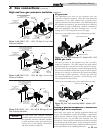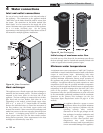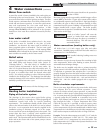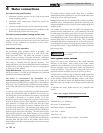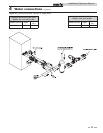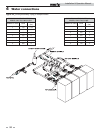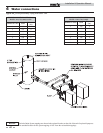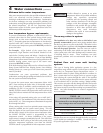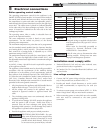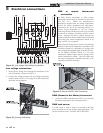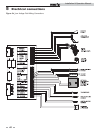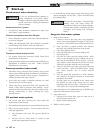
For Example: Night Setback of the system loop water
temperature, Night Shutdown and Weekend Shutdown of the
entire boiler / heating system, and Indoor / Outdoor Air Reset
of the system loop water temperature. If any of these Building
Management System control functions are being utilized on the
hydronic heating system, some type of low return water
protection MUST BE provided.
If the boiler heating system will be used on a Water Source Heat
Pump System, Radiant Floor Heating System, Snow Melting
Heating System, etc., some type of low return water protection
must be provided.
Condensation can cause operational problems, bad
combustion, sooting, flue gas spillage and reduced service life of
the vent system and related components.
To prevent the system return water temperature below 140°F
(60°C) from entering the boiler inlet, an electrically actuated
3-way mixing valve is available, consult manufacturer for kit
availability (see FIG. 4-5 on page 39). By using this valve, the
SMART SYSTEM control will bypass outlet water back into the
inlet of the boiler to maintain the inlet temperature above 140°F
(60°C).
A fast acting, self contained mixing valve, set to 140°F (60°C),
may also be used. The installation of this valve must be done as
shown in FIG. 4-5. This arrangement will maintain the required
flow through the boiler.
When a mixing valve is used, an optional system return sensor
should be installed into the system return piping. This will
allow the display of the actual system return temperature, and
will also allow control of the system return temperature when
the SMART SYSTEM control is programmed for inlet
temperature control. As always, installation of the system
supply sensor is strongly recommended as well. This will reduce
the potential for short cycling of the boiler, and provide more
responsive temperature regulation, even when the SMART
SYSTEM control is programmed for inlet temperature control.
ƽ CAUTION
A boiler allowed to operate at set point
temperatures below the specified minimum
settings may experience operational
problems with the operating controls and
safety switches, obstruction of the flue gas
passages on the heat exchanger, incomplete
combustion and possible flue gas spillage.
Operation at lower than specified water
temperatures may cause hazardous
conditions that result in non-warrantable
damage to the appliance.
Three way valves in system
The installation of a three way valve on this boiler is not
generally recommended because most piping methods allow
the three way valve to vary flow to the boiler. This boiler is a low
mass, high efficiency appliance which requires a constant water
flow rate for proper operation. Low flow rates can result in
overheating of the boiler water which can cause short burner
cycles, system noise, relief valve discharge and in extreme cases,
a knocking flash to steam. These conditions can cause
operational problems and non-warrantable failures of the
boiler.
Radiant floor and snow melt heating
systems
This type of heating boiler application operates in a low
temperature range which requires a boiler bypass as described
under the Low Temperature Bypass Requirements section. A
non-metallic rubber or plastic tubing installed in a radiant (in
floor) system must have an oxygen barrier to prevent oxygen
from entering the system through the walls of the installed
tubing. Excessive oxygen absorption into the system will result
in an accelerated rate of corrosion causing a sludge buildup.
This excessive corrosion will also damage the boiler and system
components. Sludge formed as the result of excessive oxygen in
the system can restrict water flow resulting in a premature boiler
failure. Any boiler damage due to excessive oxygenation is
non-warrantable.
TABLE - 4A
MAXIMUM FLOW FOR HEATING BOILER
The maximum flow rate through the boiler with a copper
heat exchanger must not exceed the following:
Model Maximum Flow
502, 752, 1002, and 1302 75 GPM
1501, 1701, and 2001 90 GPM
If higher flow rates are required through the boiler, an optional
Cupro-Nickel heat exchanger is available. Consult the factory
for specific application requirements.
Minimum boiler water temperatures
Inlet water temperatures below the specified minimum of 140°F
(60°C) can excessively cool the products of combustion
resulting in condensation on the heat exchanger. Condensation
on the heat exchanger can cause operational problems, bad
combustion, sooting, flue gas spillage and reduced service life of
the related components. See the Low Temperature Bypass
Requirements section for boiler system applications below the
minimum specified temperature.
Low temperature bypass requirements
To prevent condensation problems, a boiler MUST NOT be
operated (other than for brief periods during initial system
startup) with an inlet water temperature of less than 140°F
(60°C). If normal system return temperatures are less than the
required 140°F (60°C) boiler inlet requirement, a method of
low return water temperature protection MUST BE provided to
protect the boiler.
41
4 Water connections (continued)
Installation & Operation Manual



